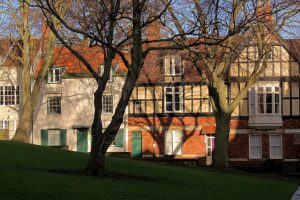Policy H4: Heritage Assets
Development proposals which affect a designated heritage asset or its setting will be approved provided that they:
- retain, repair and return designated heritage assets to appropriate compatible use; or
- they conserve designated heritage assets which are at risk of loss or destruction.
Development proposals which affect non-designated heritage assets will be approved provided that they:
- conserve and sustain these assets and their appropriate use; or
- bring back into use non-designated heritage assets at risk.
Sites of archaeological significance will be protected from development that compromises the site and its setting.
Designated and non-designated heritage assets will be protected from demolition or inappropriate development unless it can be demonstrated this is necessary to achieve sustainable public benefit that outweighs the harm or loss caused by the development.
4.56 “Listing is the term given to the practice of listing buildings, scheduling monuments, registering parks, gardens and battlefields, and protecting wreck sites” (Historic England). A listed building is a building of special architectural or historic interest, as specified by the Planning (Listed Buildings and Conservation Areas) Act 1990 (UK Parliament, 1990). Listing is made at three levels of importance: Grade I, Grade II* and Grade II. The protection applies to the whole of the listed building and any structure attached to it and the land within its curtilage that pre-dates June 1948. A scheduled monument is an historic building or site that is included in the list of Scheduled Monuments kept by the Secretary of State for Culture Media and Sport. The regime is set out in the Ancient Monuments and Archaeological Areas Act 1979 (UK Parliament, 1979).
4.57 Historic England provides the official database of all listed buildings, scheduled monuments, protected wrecks and registered parks, gardens and battlefields. Information about sites in Durham City is available in Durham County Council’s Historic Environment Record. ‘Keys to the Past’ and Durham County Council’s ‘The Durham Record’ provides publicly available information.
4.58 Non-designated heritage assets are “buildings, monuments, sites, places, areas or landscapes identified as having a degree of significance meriting consideration in planning decisions but which are not formally designated heritage assets” (PPG ‘Conserving and enhancing the historic environment’ para.039). Notable unlisted buildings in Our Neighbourhood have been identified through the Durham County Council (2016b) character appraisal of the Durham City Conservation Area. They are listed in Appendix B. These sites therefore have heritage significance which needs to be considered in planning decisions. This list in Appendix B is not exhaustive, is the situation at the time of writing (March 2019), and other non-designated heritage assets might be identified in the future.
4.59 Protection of the World Heritage Site is covered in Policy H1 and of the conservation areas in Our Neighbourhood in Policy H2. Neville’s Cross Battlefield site is additionally covered in Policy G2.
Justification
4.60 There is a statutory duty to protect listed buildings and buildings in a conservation  area under Sections 66 and 72 of the Planning (Listed Buildings and Conservation Areas) Act 1990. For a listed building, consent is required for any demolition, extension or alteration which may affect its character, appearance or significance (PPG ‘Conserving and enhancing the historic environment’ para. 045). For a scheduled monument, any work on the site, or nearby operations that might affect it, require consent from the Secretary of State. (Historic England, Identification and Designation of Heritage Assets) (PPG ‘Conserving and enhancing the historic environment’ para. 048). Designated heritage sites are dealt with under the NPPF (Chapter 16; PPG ‘Conserving and enhancing the historic environment’ para. 021 to 049). Applications for planning permissions and listed building consent require consultation/notification to a range of national bodies such as Historic England (PPG ‘Conserving and enhancing the historic environment’ para. 050 to 062).
area under Sections 66 and 72 of the Planning (Listed Buildings and Conservation Areas) Act 1990. For a listed building, consent is required for any demolition, extension or alteration which may affect its character, appearance or significance (PPG ‘Conserving and enhancing the historic environment’ para. 045). For a scheduled monument, any work on the site, or nearby operations that might affect it, require consent from the Secretary of State. (Historic England, Identification and Designation of Heritage Assets) (PPG ‘Conserving and enhancing the historic environment’ para. 048). Designated heritage sites are dealt with under the NPPF (Chapter 16; PPG ‘Conserving and enhancing the historic environment’ para. 021 to 049). Applications for planning permissions and listed building consent require consultation/notification to a range of national bodies such as Historic England (PPG ‘Conserving and enhancing the historic environment’ para. 050 to 062).
4.61 Designated and non-designated heritage assets make an invaluable contribution to the character and significance of Our Neighbourhood. Not only is the visual impact important, but the buildings and sites of heritage interest provide communal connection; the meanings of a place for the people who relate to it, or to whom it figures in their collective memory, gives a sense of identity.
NPPF (para. 197) states that:
The effect of an application on the significance of a non-designated heritage asset should be taken into account in determining the application. In weighing applications that directly or indirectly affect non-designated heritage assets, a balanced judgement will be required having regard to the scale of any harm or loss and the significance of the heritage asset.
4.62 “Local lists incorporated into Local Plans can be a positive way for the local planning authority to identify non-designated heritage assets against consistent criteria so as to improve the predictability of the potential for sustainable development.” (PPG ‘Conserving and enhancing the historic environment’ para. 041). This Plan urges Durham County Council to incorporate a local list of non-designated heritage assets in the County Local Plan (PPG para. 041) or alternatively to establish a set of criteria for assessing non-designated heritage assets.
Next section: Theme 2b: A beautiful and historic city – Green infrastructure

